Kyoto
October 12-23, 2004
Searching for the Traditional Japan
Kyoto is the traditional center of Japan, but can be surprisingly frustrating to explore. The city was founded when Emperor Kammu got tired of the constant meddling of priests in politics in Nara, and so he allowed only two temples within city limits. As a result, most of the sights of Kyoto (which are for the most part temples) are located on the fringes, at the bottom of or up in the hills that surround the city. The transit system makes matters worse: The subway lines are run by several different companies and don’t connect too well to each other or to the sights, while the buses go everywhere but are perpetually stuck in traffic. And if you’re hoping for traditional-looking neighborhoods – much of those got torn down during Japan’s post-war boom and replaced with dull gray boxes.
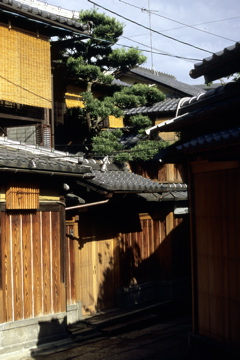 But,
with enough time to get around town and explore, there is a lot to find. And
it happened that we started in an excellent place: A ryokan near Kodai-ji (the
“ji” meaning “temple”) on the east side of the city. I had read about Kyoto’s
Traditional Building Preservation Districts in Anthony Tung’s “Preserving the
World’s Great Cities”, but hadn’t realized that our ryokan was actually part
of such a district until we started walking around in the neighborhood. These
districts are an interesting idea: Given that traditional Japanese buildings
were routinely torn down (if fire didn’t get to them first) and rebuilt anyway,
the districts don’t try to preserve specific buildings the way it would be
done in Europe. Instead, they have rules that ensure that new construction
follows traditional patterns and uses traditional materials. Given enough time,
this may lead to the demise of the dull gray boxes and the renaissance of a
traditional Japanese neighborhood.
But,
with enough time to get around town and explore, there is a lot to find. And
it happened that we started in an excellent place: A ryokan near Kodai-ji (the
“ji” meaning “temple”) on the east side of the city. I had read about Kyoto’s
Traditional Building Preservation Districts in Anthony Tung’s “Preserving the
World’s Great Cities”, but hadn’t realized that our ryokan was actually part
of such a district until we started walking around in the neighborhood. These
districts are an interesting idea: Given that traditional Japanese buildings
were routinely torn down (if fire didn’t get to them first) and rebuilt anyway,
the districts don’t try to preserve specific buildings the way it would be
done in Europe. Instead, they have rules that ensure that new construction
follows traditional patterns and uses traditional materials. Given enough time,
this may lead to the demise of the dull gray boxes and the renaissance of a
traditional Japanese neighborhood.
An Imperial Retreat
 Shugaku-in
has one of the imperial retreats near Kyoto. Designed by retired emperor Go-Mizuno-o
in the 17th century, it’s a sprawling park, partially landscaped, partially
agricultural (or maybe the fields are part of the landscape), and with a lake
that provides a foreground to Mt. Hiei. Dotted in between are three clusters
of small and informal buildings in tea house style.
Shugaku-in
has one of the imperial retreats near Kyoto. Designed by retired emperor Go-Mizuno-o
in the 17th century, it’s a sprawling park, partially landscaped, partially
agricultural (or maybe the fields are part of the landscape), and with a lake
that provides a foreground to Mt. Hiei. Dotted in between are three clusters
of small and informal buildings in tea house style.  One
of them has shelves that are considered among the three most beautiful in Japan
– they didn't look like much when seen in the dark interior of the house from
the bright outside, but the flashlight used for the photo brought them to life.
Another has stunning views over the lake, Mt. Hiei, and Kyoto.
One
of them has shelves that are considered among the three most beautiful in Japan
– they didn't look like much when seen in the dark interior of the house from
the bright outside, but the flashlight used for the photo brought them to life.
Another has stunning views over the lake, Mt. Hiei, and Kyoto.
Heian-jingu
 The
Heian shrine was built in the late 19th century, after Emperor Meiji had abandoned
Kyoto for Tokyo, in a style designed to evoke the glory of Kyoto’s founding
era. Less intentional probably, but unavoidable given that Kyoto is modeled
after the Tang-dynasty capital Chang-an, the main building looks quite Chinese
with its symmetric layout and bright colors.
The
Heian shrine was built in the late 19th century, after Emperor Meiji had abandoned
Kyoto for Tokyo, in a style designed to evoke the glory of Kyoto’s founding
era. Less intentional probably, but unavoidable given that Kyoto is modeled
after the Tang-dynasty capital Chang-an, the main building looks quite Chinese
with its symmetric layout and bright colors.  We
spend quite some time in the garden behind the building, strolling and watching
a crane that’s always in view of the camera but rarely close enough.
We
spend quite some time in the garden behind the building, strolling and watching
a crane that’s always in view of the camera but rarely close enough.
A Golden Opportunity to Practice English
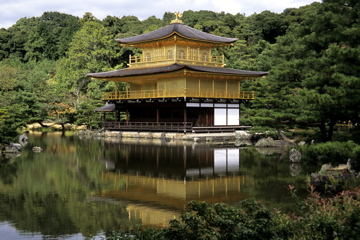 Kinkaku-ji,
the Golden Pavilion, is one of the most beautiful buildings anywhere, but it’s
apparently also the prime spot for Japanese school children to practice English.
We get “interviewed” several times, with tough questions such as where we’re
from and how often we’ve been to Japan, often assisted by a kind teacher. Each
interview ends with a photo, but some kids are so excited (or traumatized?)
by the experience that they don’t realize what happens when I make them take
the photo with my camera.
Kinkaku-ji,
the Golden Pavilion, is one of the most beautiful buildings anywhere, but it’s
apparently also the prime spot for Japanese school children to practice English.
We get “interviewed” several times, with tough questions such as where we’re
from and how often we’ve been to Japan, often assisted by a kind teacher. Each
interview ends with a photo, but some kids are so excited (or traumatized?)
by the experience that they don’t realize what happens when I make them take
the photo with my camera.
Temples, Temples, Temples
 We
visit quite a few other temples in Kyoto: Nanzen-ji, where the “tea ceremony”
turns out to be a bowl of macha served quite unceremoniously, although with
a nice enough view of a little garden with water fall, whose source we later
discover to be an aqueduct running above. Ryoan-ji, whose rock garden still
doesn’t impress me. Myoshin-ji, with subtemple after subtemple along its main
path. Kodai-ji, with the nice tea houses in its pretty garden. Kiyomizu-dera,
where the main building sits on a massive wooden platform above the valley,
and the streets ascending to it are filled with shops selling art, craft, food,
and trinkets of all kinds, and patrolled by fake geishas.
We
visit quite a few other temples in Kyoto: Nanzen-ji, where the “tea ceremony”
turns out to be a bowl of macha served quite unceremoniously, although with
a nice enough view of a little garden with water fall, whose source we later
discover to be an aqueduct running above. Ryoan-ji, whose rock garden still
doesn’t impress me. Myoshin-ji, with subtemple after subtemple along its main
path. Kodai-ji, with the nice tea houses in its pretty garden. Kiyomizu-dera,
where the main building sits on a massive wooden platform above the valley,
and the streets ascending to it are filled with shops selling art, craft, food,
and trinkets of all kinds, and patrolled by fake geishas. 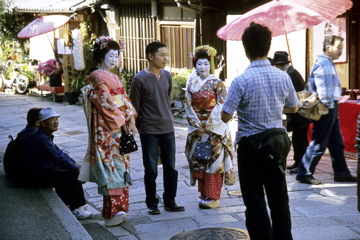 Enryaku-ji,
the guardian temple high up on Hiei-zan north-east of Kyoto.
Enryaku-ji,
the guardian temple high up on Hiei-zan north-east of Kyoto.
Museums
We get to visit a number of museums in Kyoto. One of the more interesting ones is the Kyoto Museum of Traditional Industry, whose displays show a large variety of Kyoto crafts with explanations of how they’re made. On the other side of the city, the Kyoto Museum for World Peace details the history of World War II and the nuclear arms race, as well as attempts to end the madness.
Pontocho
 Kyoto
has a number of night-life areas, but somehow we found ourselves coming back
to Pontocho. This old geisha district was traditionally considered one step
down from Gion, but maybe that’s why it feels so much more inviting. Most restaurants
display a menu outside or at least give an indication of what’s offered inside,
and many have nicely decorated entrances. The alley is narrow, car free, and
well maintained. We occasionally glimpsed a maiko (geisha in training), but
they were clearly outnumbered by tourists.
Kyoto
has a number of night-life areas, but somehow we found ourselves coming back
to Pontocho. This old geisha district was traditionally considered one step
down from Gion, but maybe that’s why it feels so much more inviting. Most restaurants
display a menu outside or at least give an indication of what’s offered inside,
and many have nicely decorated entrances. The alley is narrow, car free, and
well maintained. We occasionally glimpsed a maiko (geisha in training), but
they were clearly outnumbered by tourists.
Shopping
My friends had planned to do their Christmas shopping in Kyoto, and so we spent a lot of time visiting department stores, craft stores, craft museums, and tourist shops. It wasn’t easy. Kyoto has a huge selection, and it’s very easy to get lost. Also, after a few visits to good stores my friends developed an eye for quality, but quality is expensive. In the end, it seems, they took much less home than they’d expected.
Arashiyama
 Tucked
away in the hills west of Kyoto, this village has another cluster of temples.
At Tenryu-ji, I have to find out that the Buddhist lunch set is no longer offered
in the open hall overlooking the magnificent garden, but in a new box off to
the side of the temple complex. Like everybody else, I choose to skip it. Two
gardeners are trimming the trees that overhang the pond. After a lunch of nishin
soba (noodles with herring), I walk over to the Rakushisha, the hermitage of
a 17th century haiku poet.
Tucked
away in the hills west of Kyoto, this village has another cluster of temples.
At Tenryu-ji, I have to find out that the Buddhist lunch set is no longer offered
in the open hall overlooking the magnificent garden, but in a new box off to
the side of the temple complex. Like everybody else, I choose to skip it. Two
gardeners are trimming the trees that overhang the pond. After a lunch of nishin
soba (noodles with herring), I walk over to the Rakushisha, the hermitage of
a 17th century haiku poet.  After
that, Daikaku-ji, where several buildings are currently under renovation, but
the remaining halls still make for a pleasant visit.
After
that, Daikaku-ji, where several buildings are currently under renovation, but
the remaining halls still make for a pleasant visit.
A Festival or a History Lesson?
 Japanese
festivals are usually occasions where people have fun, eat delicious junk food
from stalls, get drunk, and listen to the beat of taiko drums, along with watching
whatever gave rise to the festival – usually some religious ceremony. The Jidai
Matsuri, or Festival of the Ages, is different – it’s a costume parade with
all the excitement of a history lesson. It started in 1895, after the Emperor
had abandoned Kyoto for Tokyo, to show off Kyoto’s 1200-year history (and,
as attentive readers might guess, the parade ends at the Heian shrine). Many
of the dresses individually are actually quite nice to look at, but after one-and-a-half
hours and 2000 people strolling by all the kimono and funny hats become a bit
of a blur, and the Starbucks on the other side of the street starts to look
very attractive.
Japanese
festivals are usually occasions where people have fun, eat delicious junk food
from stalls, get drunk, and listen to the beat of taiko drums, along with watching
whatever gave rise to the festival – usually some religious ceremony. The Jidai
Matsuri, or Festival of the Ages, is different – it’s a costume parade with
all the excitement of a history lesson. It started in 1895, after the Emperor
had abandoned Kyoto for Tokyo, to show off Kyoto’s 1200-year history (and,
as attentive readers might guess, the parade ends at the Heian shrine). Many
of the dresses individually are actually quite nice to look at, but after one-and-a-half
hours and 2000 people strolling by all the kimono and funny hats become a bit
of a blur, and the Starbucks on the other side of the street starts to look
very attractive.
Kurama by Night
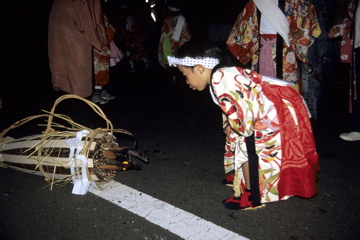 The
Kurama-no-hi Matsuri, or Fire Festival, is on the same day as the Jidai Matsuri,
but quite the opposite flavor. Kids, teenagers, and men carry torches through
the small town’s main street, first to the small shrines along the street,
then to the main shrine at the top end of it. Near the main shrine, thousands
of visitors from Kyoto, Germany, and other places throng and block each other
from seeing anything, and the night is illuminated by hundreds of camera phone
screens. It’s clearly a case of an event having become too popular for its
own good.
The
Kurama-no-hi Matsuri, or Fire Festival, is on the same day as the Jidai Matsuri,
but quite the opposite flavor. Kids, teenagers, and men carry torches through
the small town’s main street, first to the small shrines along the street,
then to the main shrine at the top end of it. Near the main shrine, thousands
of visitors from Kyoto, Germany, and other places throng and block each other
from seeing anything, and the night is illuminated by hundreds of camera phone
screens. It’s clearly a case of an event having become too popular for its
own good.  But
in the lower parts of town, it feels small-scale and friendly. I spend most
of the evening there, watching people preparing the torches and hanging out
in front of their houses with neighbors, and never make it to the main shrine.
But
in the lower parts of town, it feels small-scale and friendly. I spend most
of the evening there, watching people preparing the torches and hanging out
in front of their houses with neighbors, and never make it to the main shrine.
Kurama by Day
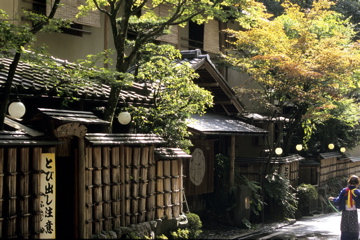 Having
liked what I saw of the town at night, I decide to go back the next day. I
get off the train at Kibune, the stop before Kurama, and walk through that
town and then hike across the ridge that separates the two. There are plenty
of temple and shrine buildings dotted in the forest, and the fall leaves and
crisp air make it a very pleasant day. In Kurama, some cleanup work was still
in progress. In particular, the restaurant just below the shrine had a construction
crew stabilizing the front wall – apparently the crowd had pushed a little
too hard the night before.
Having
liked what I saw of the town at night, I decide to go back the next day. I
get off the train at Kibune, the stop before Kurama, and walk through that
town and then hike across the ridge that separates the two. There are plenty
of temple and shrine buildings dotted in the forest, and the fall leaves and
crisp air make it a very pleasant day. In Kurama, some cleanup work was still
in progress. In particular, the restaurant just below the shrine had a construction
crew stabilizing the front wall – apparently the crowd had pushed a little
too hard the night before.  Their
temple-style food was excellent nevertheless.
Their
temple-style food was excellent nevertheless.
Open Toilets
 A
Japanese friend of mine had complained about the open toilets she encountered
on a recent trip to China. I thought I had seen some in Japan as well, but
was surprised how many I found after I actually started paying attention to
them. This one was on the hiking trail between Kibune and Kurama, where standing
behind a little hut may seem progress over standing behind a tree. But I observed
similar openness in the middle of the nightlife district of Osaka, at the corner
of Dotombori and Ebisubashi. Sorry, no photo of that facility – it was constantly
in use. Interestingly though, it was generally only the men’s facilities that
were exposed – there were always doors for women to hide behind.
A
Japanese friend of mine had complained about the open toilets she encountered
on a recent trip to China. I thought I had seen some in Japan as well, but
was surprised how many I found after I actually started paying attention to
them. This one was on the hiking trail between Kibune and Kurama, where standing
behind a little hut may seem progress over standing behind a tree. But I observed
similar openness in the middle of the nightlife district of Osaka, at the corner
of Dotombori and Ebisubashi. Sorry, no photo of that facility – it was constantly
in use. Interestingly though, it was generally only the men’s facilities that
were exposed – there were always doors for women to hide behind.